Home based Women Embroiderers of Aligarh: An Insight into their Work and Working Conditions
Keywords:
Women, Home Based Workers, Aligarh, Patti Work, Cut Work, KarchobiAbstract
The conditions of labour in unorganized sector and home based aspect of work having risen inthe years on account of structural adjustments in globalized economy has been much covered theme ofstudy. The gendered aspect of the home based productive work including the craft of embroidery has also received attention of scholars. In case of embroidery workers, however, particular attention had been on chikankari of Lucknow and phulkari of Punjab. This study therefore is an extension of the attempts to understand the work and conditions of embroidery workers in Aligarh. Here while the case of lock industry, for which Aligarh remains quite famous, has still been taken for study in some ways the other major craft of Aligarh, involving women working in the home based sector, however, has not received sufficient attention. The attempt is made here to bring out through the case study of embroidery workers in Aligarh, the conditions of home based women embroiderers in the current economic scenario. The paper looks into the monthly earnings, working hours, value chain in the process of work, classification of embroiderers according to their incomes, etc. In the patti business there are men, but mainly as entrepreneurs, contractors, subcontractors while few of them are also tracers, tailors and launderers but not as patti embroiderers. In this gendered division of labour, women embroiderers working from homes earn little, while the male contractors, traders, shopkeepers earn higher profits. This is perhaps on account of embroidery considered as leisurely engagement for women and her skills considered rudimentary. Embroiderers themselves regard their work as little specialized and requiring lesser skills.Different types of embroidery done in Aligarh by women are patti ka kaam, karchobi, cut work, zari, moti work, aari work, gaanth ki kadhai, etc. The study primarily took up patti embroiderers for study as it is the famous embroidery of Aligarh. For the sake of comparison wherever possible, samples were also taken from cut work embroidery and karchobi embroidery (the sample had 140 patti embroiderers and only 50 cut work and 30 karchobi embroiderers in the total of 220).
Metrics
References
Government of India. (2008). Report on Conditions of Work and Promotion of Livelihoods in the Unorganized Sector. New
Delhi: Academic Foundation.
Ibid
Minault, G. (1998): Secluded Scholars Women's Education and Muslim Social Reform in Colonial India, Delhi: Oxford
University Press.
Wilkinson-Weber, Clare M. (1997): Dependency and Differentiation: Agents and Embroiderers in the Lucknow Embroidery
Industry. Ethnology, Vol. 36 (No.1), pp. 49-65.
Downloads
Published
How to Cite
Issue
Section
License

This work is licensed under a Creative Commons Attribution-NonCommercial 4.0 International License.









